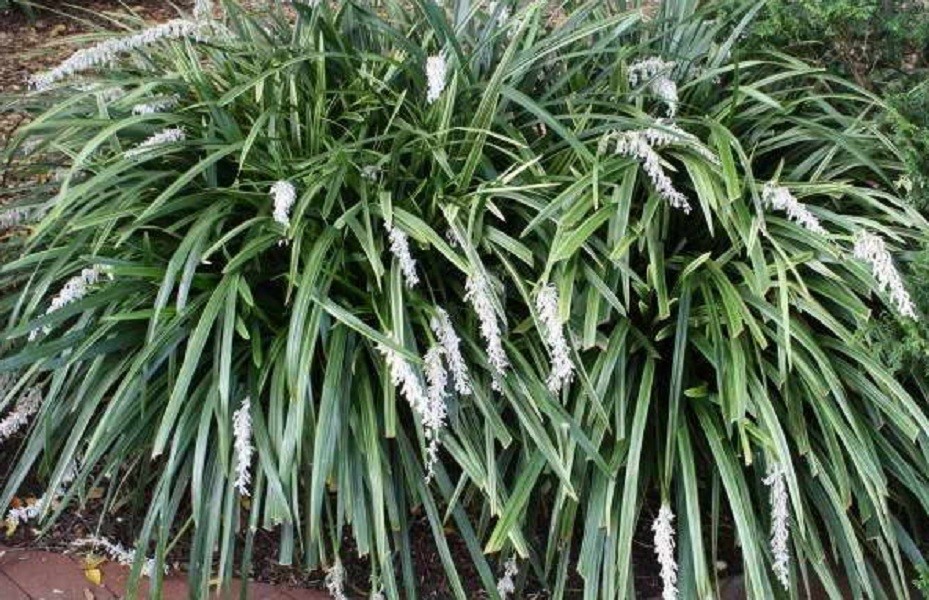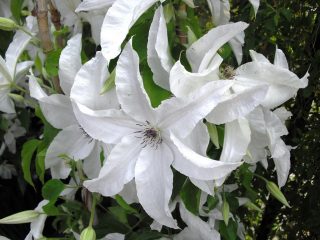Content
Photos and descriptions of ophiopogon show that it is a herbaceous perennial from the Liliaceae family, better known as snakebeard, lily of the valley or dragon's sting. It has been successfully cultivated as an ornamental plant and has long been used in Chinese folk medicine.
Description of ophiopogon
Snakebeard is a perennial plant with greatly shortened stems and fibrous roots, on which tuberous thickenings are noticeable. The long, narrow-linear leaves of lily of the valley grow up to 35 cm and are collected in dense rosettes.

Ophiopogon leaves are covered with smooth dark green skin on top and have pronounced longitudinal veins underneath.
During the growth process, lily of the valley forms thin elongated stolons-shoots, which ensure strong growth of the perennial. The snakebeard blooms from July to September. During this period, ophiopogon throws out a meek peduncle, on which 15-20 buds are formed.Small, loosely growing flowers develop in a loose inflorescence - a drooping axillary spike up to 70 mm long and consist of six petals, colored purple or pink.

Ophiopogon bears fruit with round, blue-black berries, inside of which there are small seeds.
Types and varieties of ophiopogon
This genus of Ophiopogon unites about 20 species. Some of them are successfully grown at home, thanks to good immunity and unpretentiousness to growing conditions.
Ophiopogon yaburan
A large herbaceous perennial ophiopogon bush grows up to 80 cm in height. Its lush rosettes consist of many leathery, linear leaves, blunt at the edges. The outer surface of the snakebeard plates is painted in a dark green shade, the lower part is dotted with relief longitudinal veins. During the flowering period, ophiopogon yaburan produces an erect peduncle.

Ophiopogon yaburan is crowned with an inflorescence consisting of many white or light lilac tubular flowers in the form of a lily of the valley
Ophiopogon japonica
A herbaceous perennial snakebeard with a rhizome consisting of short nodules with fibrous roots, and hard, narrow, upward-directed leaves, curving towards the center. The width of the lily of the valley plates is approximately 25 mm, and the length does not exceed 35 cm. During the flowering period, the Japanese lily of the valley throws out a short peduncle, on which a small inflorescence is formed.

The petals of ophiopogon flowers are colored red or lilac and are curled into a tube.
Of the existing variety of varieties of Japanese lily of the valley, the most noteworthy are the dwarf ophiopogon Kyoto Dwarf with a maximum height of 10 cm, the small Compactus with a dense leaf rosette and the variegated Silver Dragon with beautiful green plates along the edges of which there are longitudinal white stripes. Experts also recommend paying attention to the miniature darter variety Nana. Ophiopogon is a ground cover species and grows no higher than 10 cm.

According to many biologists, varieties of Japanese lily of the valley such as Minor and Silver Fog are highly decorative.
Ophiopogon flat-arrowed
A spectacular perennial snakebeard with unusual purple-burgundy leaves collected in lush rosettes. Ophiopogon is characterized by rapid growth and blooms from July until the onset of the first frost.

With the arrival of cold weather, shiny violet-violet-black fruits appear in place of the white or pink flowers of the Argentine beetle.
Of the known varieties, the most popular is Ophiopogon Black Dragon. It is a lush bush with a maximum height of 30 cm with black leaves and the same fruits. Black dragon snakebeard easily tolerates cold temperatures down to -25 0C.

Lily of the valley Black Dragon has received many awards, in particular, a certificate from the British Royal Horticultural Association
Of no less interest is the flat-shot ophiopogon Niger; the botanical description of the variety states that it stretches up to 15-20 cm and changes color as it grows. Over time, the young green foliage of Darterbeard turns purple.

Lily of the valley variety Niger blooms with soft lilac flowers
Indoor ophiopogon
Ophiopogon is grown as an ornamental plant due to its dense rosettes and beautiful leaves. Of particular interest is the darter beetle variety Nigrescens. The glossy leaves of this ophiopogon have a graphite tint.

The leaf blades of the Nigrescens variety create a unique backdrop for spectacular flowering plants
Ophiopogon Minor is also grown in indoor culture. This is a heat-loving dwarf variety of darterbeard up to 10 cm high.

Darterbeard Minor blooms with white or light lilac flowers, which are later replaced by dark blue or purple berries
Reproduction of ophiopogon
Lily of the valley is propagated by two methods: seeds and division of the rhizome. The latter option for ophiopogon is less labor-intensive and is more popular among gardeners.
Growing from seeds
A long and labor-intensive method of propagating the darter, which involves independent collection and preparation of seed material. In the fall, around the end of October or beginning of November, fully ripened black or dark purple fruits are picked from the ophiopogon, crushed with fingers or a teaspoon, and the seeds are extracted. The harvested snakebeard grains are washed to remove the pulp and soaked in water for several days to speed up germination.A few days later, the seeds are rinsed again, dried and scattered in a box filled with a peat-sand mixture. Ophiopogon seeds are distributed so that the distance between them is about 30-40 mm, and lightly sprinkled with soil. The containers are covered with glass or transparent film to ensure a greenhouse effect and placed in a cool room where the air temperature is kept at +10 0C.

Lily of the valley crops are ventilated daily and watered with warm water as needed.
With proper care and compliance with the recommended conditions, the first shoots of the snakebeard will appear in about 3-5 months. When ophiopogon seedlings reach 50-70 mm, they are planted in individual cups. Lily of the valley seedlings are determined for a permanent place when they grow to 10 cm.
Dividing the bush
During the growing season, the ophiopogon flower produces many lateral shoots, which are used for propagation. The procedure is carried out in late spring or early summer. The selected ophiopogon bush is dug out of the ground and divided into several fragments, each of which must have at least four rosettes. The resulting cuttings of the snakebeard are planted in light, nutritious soil, deepening them to the level of the root collar.

In order for the lily of the valley sections to take root well and take root in a new place, they are regularly watered with settled water.
Planting and caring for ophiopogon in open ground
The recommended time to transplant lily of the valley into open ground is spring or autumn. In regions with warm climates this is done in September. In other areas - in May, when the threat of return frosts, dangerous for ophiopogon, has passed.
Lily of the valley grows well in warm, windless areas with moist, permeable, humus, slightly acidic soil. Depending on the color of the foliage, it can be planted in shade, partial shade or full sun. For example, varieties with dark leaves need shade, while variegated plants grow well in full sun.
Ophiopogon is placed in a flowerbed in groups so that there are 7-9 bushes on each square meter. For a beautiful ground cover effect, the distance between neighboring seedlings, depending on the size of the variety and the required growth rate, is 20-60 cm. The planting itself is carried out according to the following scheme:
- The selected area is weeded from weeds and dug well.
- They dig a hole, the diameter of which is 2-3 times the width of the root ball of the bush.
- The seedling is planted in a mixture of garden soil and compost, the soil around is compacted and watered.
If ophiopogon grass is planned to be grown on heavy soils, gravel, pebbles or coarse sand are poured into the planting holes to improve drainage.
The snakebeard is watered on average 1-2 times a week. In dry, hot weather this is done more often. To maintain moisture in the soil around ophiopogon plantings, the soil must be mulched with compost in the spring.
Like any other plant, lily of the valley needs feeding. In the summer, mineral complexes are added under the snakebeard.

In September, the area where ophiopogon grows is fertilized with leaf humus
Snakebeard easily adapts to the meteorological conditions of the middle zone, but is not a completely frost-resistant crop. The evergreen leaves of lily of the valley easily tolerate spring and autumn frosts, and with an abundance of snow, even average winter frosts.Considering the relatively low winter hardiness of ophiopogon, when grown in Siberia and other regions with harsh climates, the plant is mulched with fallen leaves and covered with spruce branches in late autumn.
Diseases and pests
Ophiopogon is characterized by stable immunity to viral and fungal diseases, but with excessively intense watering it can suffer from root rot. Of the harmful insects, the greatest danger to lily of the valley is:
- Whiteflies. Small white butterflies cause yellowing and falling leaves. To combat adult individuals, sticky traps are used.
Dandelion infusion, soap or garlic solution, as well as the chemicals Tanrek, Confidor, Karbofos, Zeta are effective against whiteflies.
- Spider mite. Small arthropods leave a barely noticeable web on the leaves of the darter and provoke yellowing and shedding of the plates.
Actellik, Fitoverm and sulfur powders are used to combat mites.
- Thrips. The leaves of the affected lily of the valley are covered with small brown dots on the bottom. With extensive infection, the snakebeard begins to turn yellow, wither and crumble.
To combat thrips, ophiopogon is dusted with sulfur powders or treated with anabasine sulfate in a soap solution.
- Slugs, snails. Characteristic marks remain on the surface of the snakebeard leaves and through holes appear.
Copper preparations, superphosphate granules, mustard and hot pepper, a mixture of wood ash with tobacco dust and baking soda are used against slugs.
Ophiopogon in landscape design
Snakebeard is widely used for landscaping city parks, squares and garden plots.

Lily of the valley forms spectacular carpets of evergreen foliage and is used to create modern decorations
The universal snake beard is used for decorating residential premises, zoning flower beds, decorating flower beds, edging paths and creating low borders.

The ground cover of the perennial snakebeard goes well with many plants with similar requirements for the growing location
Spring bulbous flowers, hostas, ferns, pachysandra, bergenia, perennial geranium, mouse hyacinth, small periwinkle and epimedium are considered good neighbors for ophiopogon.

The low lily of the valley looks impressive against the backdrop of heather thickets and next to magnolias, hydrangea and Japanese maple
Fans of Japanese gardens will love the combination of ophiopogon with nandina, bamboo, azaleas and rhododendron.

In Japan, low varieties of lily of the valley that tolerate light trampling are used as an alternative to turf.
Conclusion
Photos and descriptions of ophiopogon will help you decide on the choice of the appropriate crop variety. Many types of lily of the valley look equally impressive both in a flower bed and in a flowerpot.















